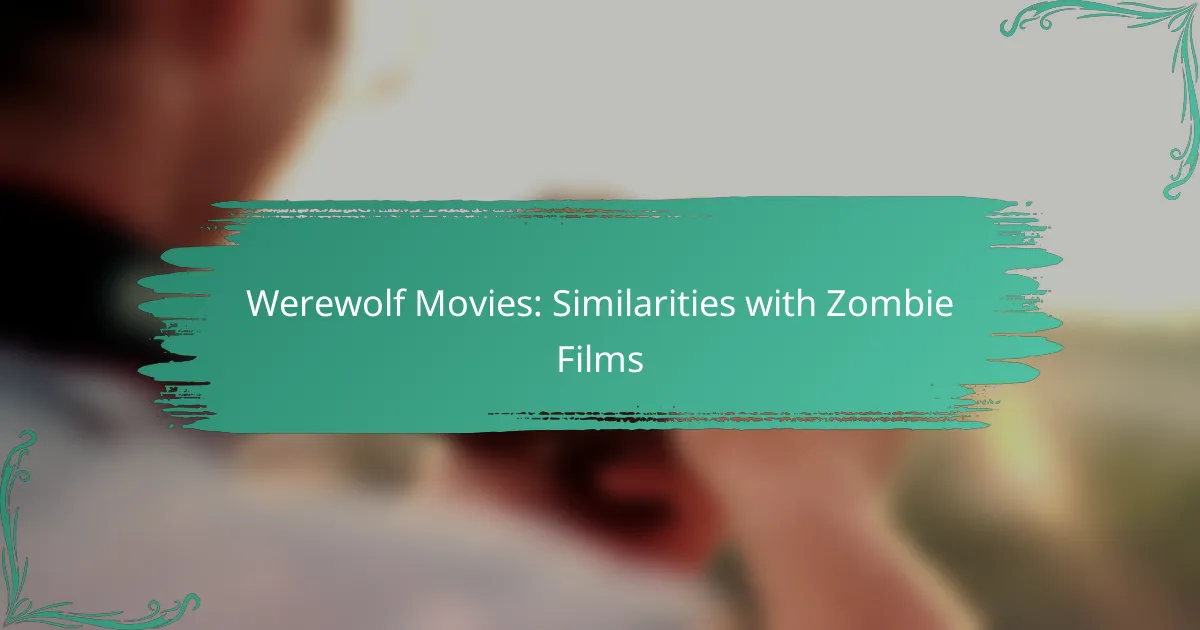Werewolf movies and zombie films exhibit striking similarities, particularly in their exploration of transformation, survival, and societal breakdown. Both genres delve into the human experience through the lens of monstrous changes, highlighting the psychological and physical struggles faced by characters in chaotic environments. These narratives often evoke themes of duality and the fight for existence against insurmountable challenges.
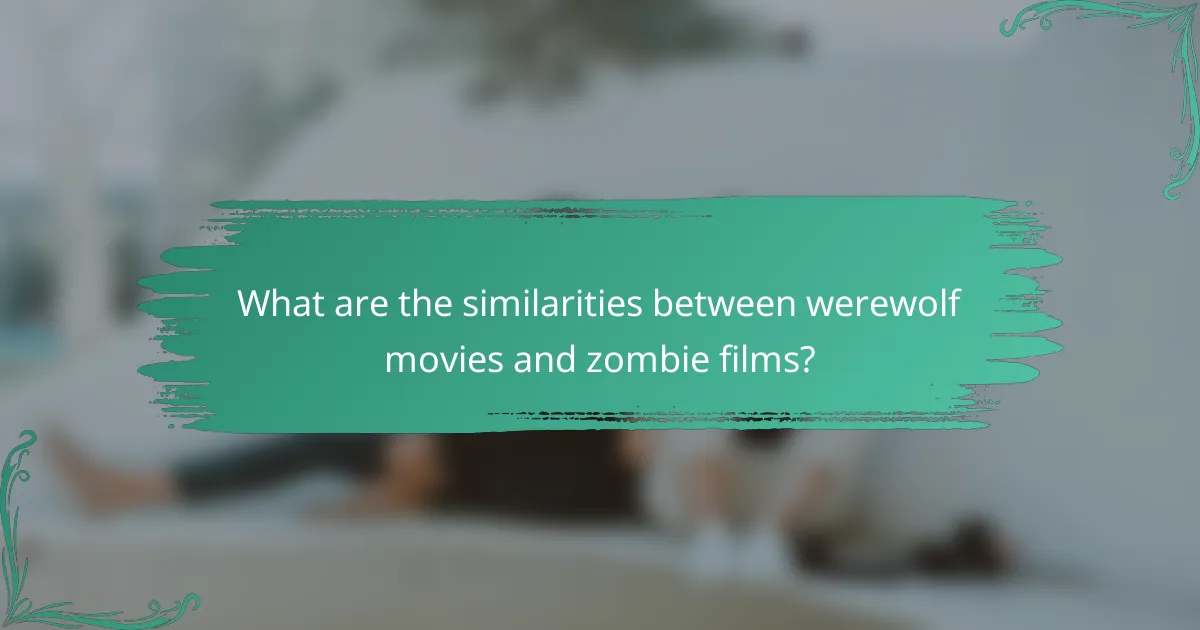
What are the similarities between werewolf movies and zombie films?
Werewolf movies and zombie films share several key similarities, primarily revolving around themes of transformation, survival, and social commentary. Both genres explore the human condition through monstrous transformations and the struggle for survival in a chaotic world.
Transformation themes
Transformation is a central theme in both werewolf and zombie films, representing a loss of control over one’s identity. In werewolf movies, characters undergo a physical change during the full moon, often struggling with their dual nature. Similarly, zombies embody the transformation from human to mindless creature, highlighting the fragility of humanity.
These transformations serve as metaphors for various societal fears, such as the loss of individuality or the impact of disease. Both genres illustrate how external forces can alter a person’s essence, leading to a struggle between the human and the monstrous.
Survival horror elements
Survival horror is a critical aspect of both werewolf and zombie films, emphasizing the fight for survival against overwhelming odds. Characters often find themselves in life-or-death situations, requiring them to make difficult choices to stay alive. This element creates tension and suspense, drawing viewers into the characters’ plight.
In both genres, the threat is not only from the creatures themselves but also from the breakdown of societal order. Survivors must navigate not only physical dangers but also moral dilemmas, which adds depth to the horror experience.
Social commentary
Both werewolf and zombie films often provide social commentary on contemporary issues, reflecting societal anxieties. Werewolf movies can explore themes of addiction, repression, and the struggle for self-acceptance, while zombie films frequently comment on consumerism, conformity, and the loss of individuality in modern society.
This social critique is woven into the narratives, prompting audiences to reflect on their own lives and the world around them. By using horror as a lens, these films encourage viewers to confront uncomfortable truths about humanity and society.
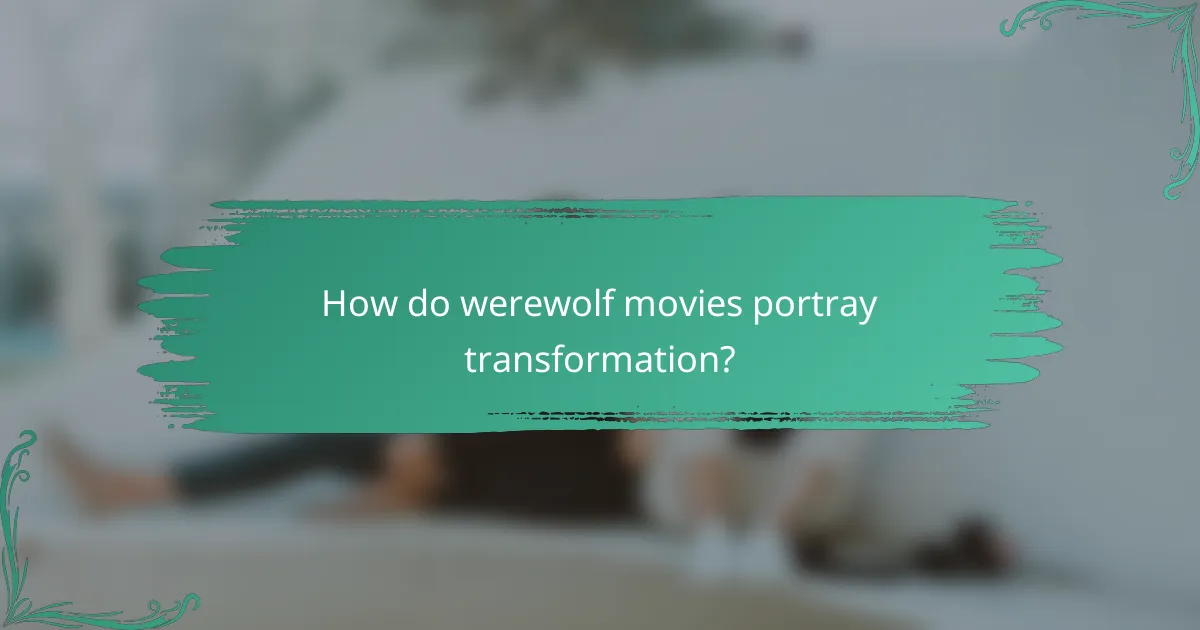
How do werewolf movies portray transformation?
Werewolf movies typically depict transformation as a dramatic and painful process, often triggered by the full moon. This transformation not only alters the physical form but also significantly impacts the character’s psyche, leading to a duality of identity.
Physical changes
The physical transformation in werewolf films is characterized by rapid and grotesque alterations to the human body. Common features include the elongation of limbs, growth of fur, and the development of sharp claws and teeth. These changes often emphasize the beastly nature of the werewolf, contrasting sharply with the character’s human form.
For instance, the transformation may involve bone cracking and muscle expansion, creating a visceral experience for the audience. This physical metamorphosis serves as a visual representation of the struggle between humanity and primal instincts.
Mental shifts
Mental shifts during transformation are equally significant, as characters often experience a loss of control and a surge of aggression. The werewolf persona typically embodies primal urges, leading to violent behavior that the human side cannot contain. This internal conflict highlights themes of identity and morality.
In many films, the character’s memories and rational thoughts fade during the transformation, leaving only the instinctual drive to hunt. This duality creates tension, as the character grapples with the consequences of their actions once they revert to human form, often leading to feelings of guilt and horror.
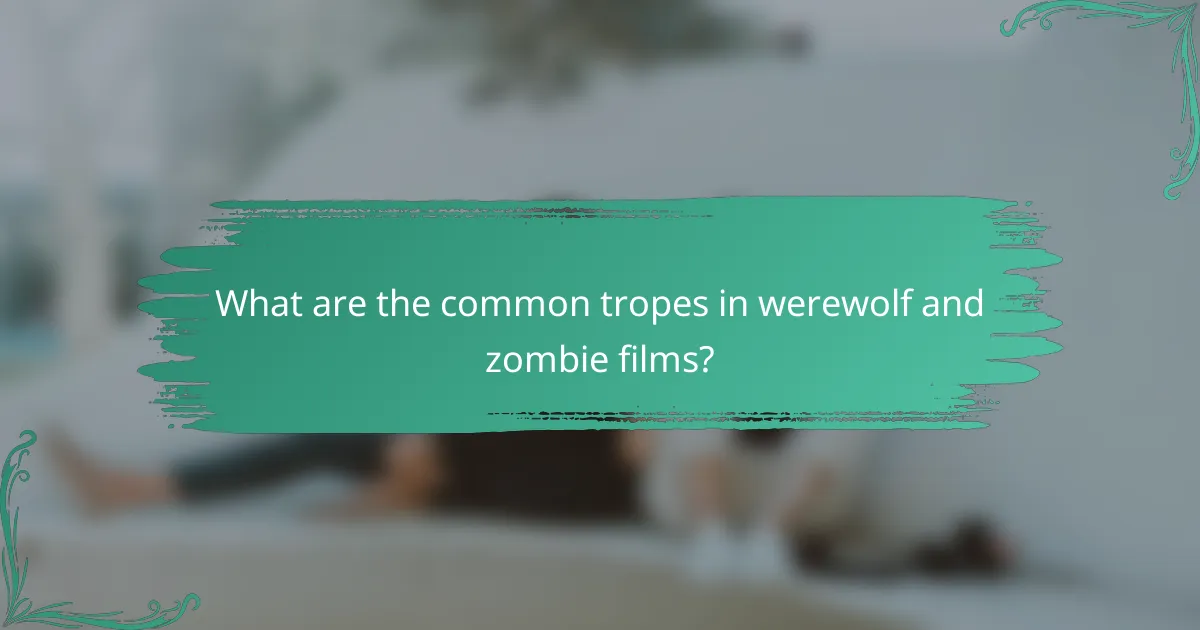
What are the common tropes in werewolf and zombie films?
Werewolf and zombie films share several common tropes that create a sense of dread and urgency. Both genres often feature transformations, societal collapse, and the struggle for survival against overwhelming odds.
Apocalyptic settings
Both werewolf and zombie films frequently take place in apocalyptic or post-apocalyptic environments. These settings amplify the horror, as characters navigate through desolate landscapes, abandoned cities, or rural areas where danger lurks at every corner. The collapse of civilization serves as a backdrop, highlighting the fragility of human life.
In zombie films, the apocalypse is often caused by a viral outbreak, while werewolf narratives may focus on the chaos unleashed by a single creature or a pack. This creates a sense of urgency and desperation, forcing characters to confront their fears and fight for survival.
Character archetypes
Character archetypes in werewolf and zombie films often overlap, featuring similar roles that drive the narrative. Common figures include the reluctant hero, who must embrace their fate, and the skeptic, who initially doubts the threat but eventually faces the reality of the situation. These archetypes help to create relatable characters that audiences can connect with.
Additionally, both genres often include a wise mentor figure who provides guidance, as well as a group of survivors who must work together to overcome the monstrous threat. The dynamics within these groups can lead to tension and conflict, further enriching the story.
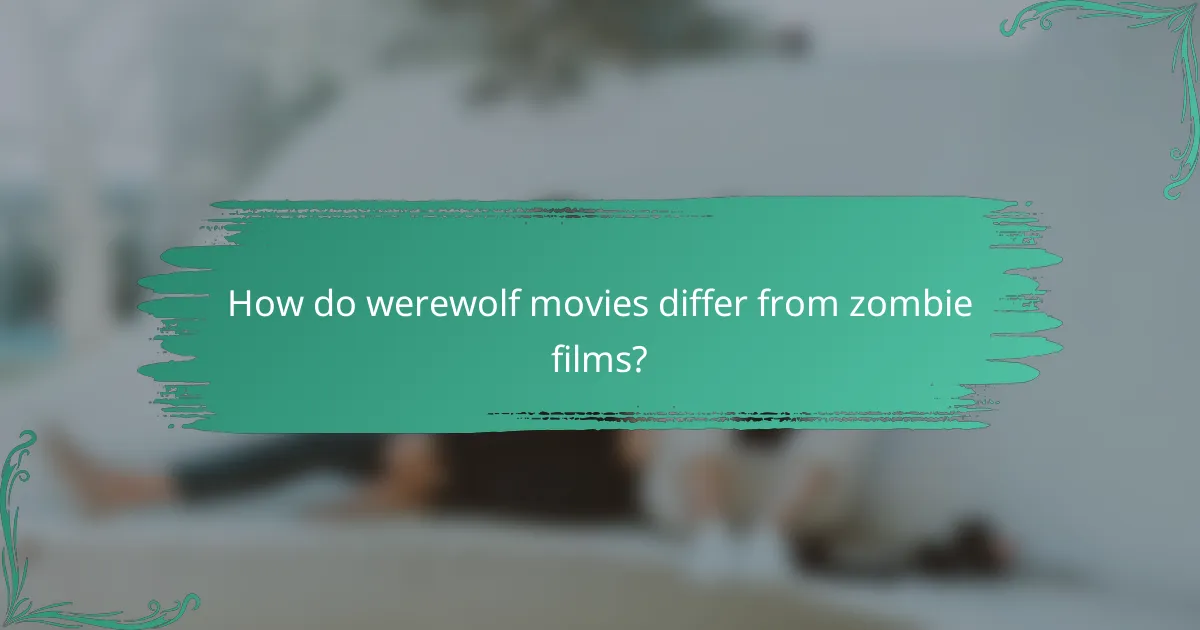
How do werewolf movies differ from zombie films?
Werewolf movies and zombie films differ primarily in their themes, character arcs, and the nature of their monsters. While werewolf films often explore the duality of human nature and personal transformation, zombie films typically focus on survival and societal collapse.
Origin stories
The origin stories of werewolves often involve a curse or a traumatic event, such as being bitten by another werewolf or experiencing a significant emotional trauma. This transformation is usually tied to the lunar cycle, emphasizing themes of change and loss of control.
In contrast, zombie films frequently depict a viral outbreak or apocalyptic event as the catalyst for the undead’s rise. These origins are often rooted in science fiction, exploring the consequences of human experimentation or environmental disasters.
Character motivations
In werewolf films, characters often struggle with their inner beast, battling their instincts and the consequences of their transformations. This internal conflict can lead to themes of redemption or tragedy, as characters seek to control or accept their dual nature.
Zombie films, however, typically focus on survival instincts. Characters are motivated by the need to escape danger, protect loved ones, or find resources. The emphasis is on collective survival rather than personal transformation, often highlighting the breakdown of social order and morality in crisis situations.
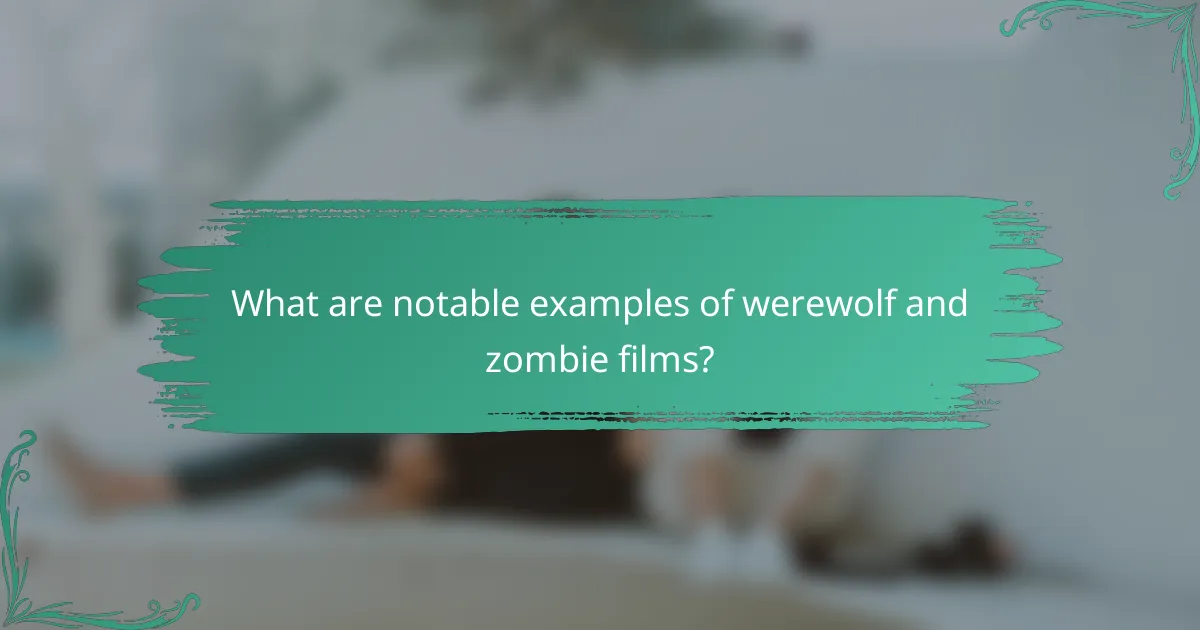
What are notable examples of werewolf and zombie films?
Notable examples of werewolf and zombie films include “American Werewolf in London” and “28 Days Later.” Both films showcase unique storytelling techniques and thematic elements that highlight the horror and transformation associated with their respective creatures.
American Werewolf in London
“American Werewolf in London,” released in 1981, is a landmark film that blends horror and dark comedy. It follows two American backpackers who encounter a werewolf while traveling in England, leading to one of them becoming a werewolf himself.
The film is renowned for its groundbreaking special effects, particularly the transformation scene, which set a new standard in the genre. Its mix of humor and horror creates a unique viewing experience, making it a classic in werewolf cinema.
28 Days Later
“28 Days Later,” released in 2002, revitalized the zombie genre with its intense narrative and fast-moving infected. The film depicts a post-apocalyptic world where a virus has turned most of the population into rage-fueled zombies, focusing on the struggle for survival.
This film is notable for its commentary on societal collapse and human resilience. Its use of a deserted London as a backdrop adds to the eerie atmosphere, making it a significant entry in zombie film history.

What cultural impacts do werewolf and zombie films have?
Werewolf and zombie films significantly influence cultural narratives, reflecting societal fears and moral dilemmas. Both genres explore themes of transformation, survival, and the human condition, resonating with audiences across different eras.
Influence on pop culture
Werewolf and zombie films have left a lasting mark on pop culture, inspiring various forms of media including television shows, video games, and literature. Iconic characters like the werewolf and the zombie have become archetypes, often symbolizing deeper societal issues such as the fear of the unknown or loss of control.
These films frequently spawn catchphrases and references that permeate everyday language, contributing to their cultural relevance. For instance, phrases like “zombie apocalypse” or “full moon transformation” are commonly used in various contexts, showcasing their integration into popular discourse.
Merchandising opportunities
The popularity of werewolf and zombie films creates substantial merchandising opportunities, ranging from action figures to apparel. Fans often seek memorabilia that connects them to their favorite films, driving demand for themed products.
Merchandising can extend to collectibles, such as limited edition DVDs or exclusive artwork, which can appeal to dedicated fans. Additionally, events like horror conventions often feature booths selling related merchandise, further solidifying the cultural impact of these genres.

How do audiences perceive werewolf movies compared to zombie films?
Audiences often view werewolf movies as more character-driven and emotionally complex than zombie films, which tend to focus on survival and societal collapse. While both genres explore themes of transformation and loss of control, werewolf narratives frequently delve into the human psyche, making them resonate differently with viewers.
Viewer engagement
Viewer engagement in werewolf movies often stems from the emotional journey of the protagonist, who struggles with their dual nature. This internal conflict can create a deeper connection with the audience, as they empathize with the character’s plight. In contrast, zombie films typically engage viewers through intense action and suspense, focusing on the immediate threat posed by the undead.
For example, films like “An American Werewolf in London” blend horror with humor and character development, enhancing viewer investment. Zombie films like “World War Z” prioritize fast-paced sequences and large-scale chaos, which can lead to a more adrenaline-driven experience but less emotional depth.
Box office performance
Box office performance for werewolf films generally lags behind that of zombie films, which have seen significant commercial success in recent years. While werewolf movies can achieve cult status, they often struggle to attract mainstream audiences, resulting in lower overall earnings.
For instance, major zombie films such as “The Walking Dead” series and “Train to Busan” have grossed hundreds of millions globally, while many werewolf films tend to earn in the lower tens of millions. This discrepancy reflects the broader appeal of zombie narratives in popular culture, often driven by their action-oriented plots and societal commentary.
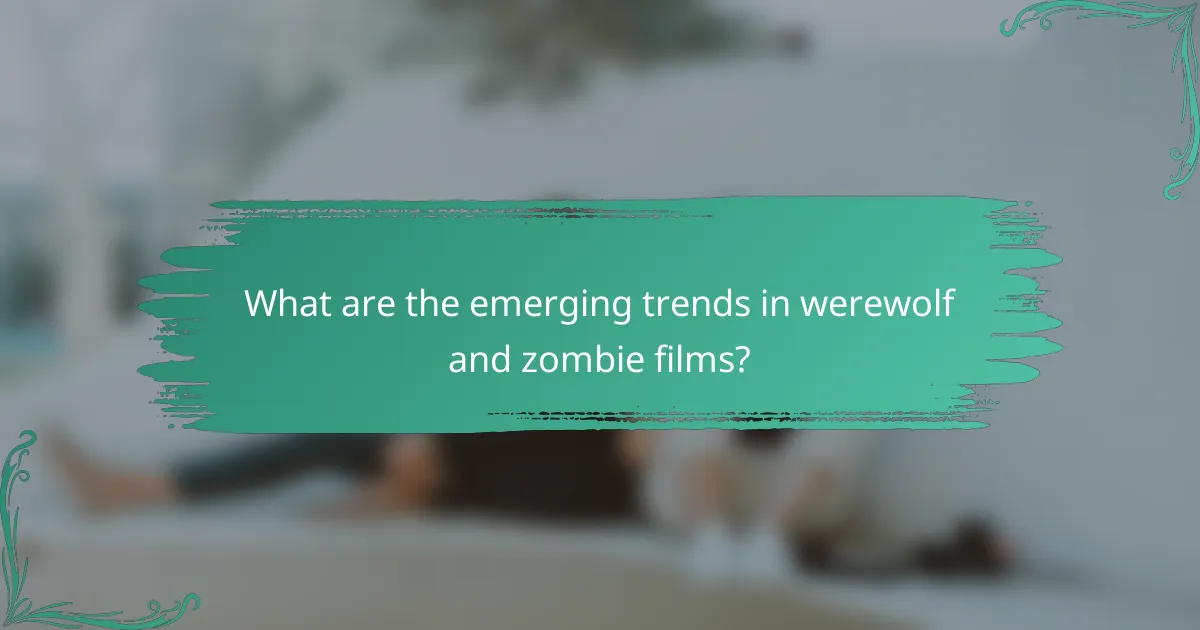
What are the emerging trends in werewolf and zombie films?
Emerging trends in werewolf and zombie films highlight a growing interest in blending genres and exploring deeper themes. Filmmakers are increasingly combining elements of horror with drama, comedy, and even romance, creating unique narratives that resonate with modern audiences.
Hybrid genres
Hybrid genres in werewolf and zombie films often merge traditional horror with other styles, resulting in innovative storytelling. For instance, a werewolf film might incorporate romantic elements, creating a love story set against the backdrop of a supernatural transformation. Similarly, zombie films may blend comedy, leading to a lighter take on the apocalypse.
These hybrids allow filmmakers to explore complex themes, such as identity and morality, while still delivering the thrills associated with horror. Examples include films like “Warm Bodies,” which combines romance with a zombie narrative, and “What We Do in the Shadows,” which humorously portrays vampire life alongside werewolf characters.
When creating or selecting films in these hybrid genres, consider the balance between horror and the secondary genre. A successful blend can enhance the story, but overemphasis on one aspect may dilute the impact of the other. Look for films that maintain tension while skillfully integrating humor or romance to ensure a compelling viewing experience.
